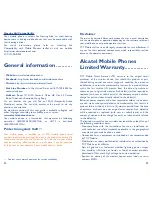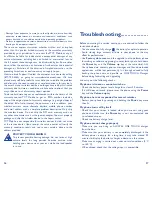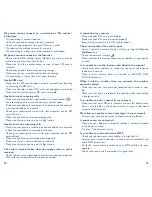
30
31
It is the user’s sole responsibility to ensure that prior authorization
be obtained, if necessary, in order to record private or confidential
conversations or take a photograph of another person; the
manufacturer, the seller or vendor of your mobile phone (including
the operator) disclaim any liability which may result from the
improper use of the mobile phone.
•
BATTERY AND ACCESSORIES:
Before removing the battery from your mobile phone, please make
sure that the mobile phone is switched off.
Observe the following precautions for battery use:
- Do not attempt to open the battery (due to the risk of toxic
fumes and burns).
- Do not puncture, disassemble or cause a short-circuit in a battery,
- Do not burn or dispose of a used battery in the garbage or store it
at temperatures above 60°C (140°F).
Batteries must be disposed of in accordance with locally applicable
environmental regulations. Only use the battery for the purpose for
which it was designed. Never use damaged batteries or those not
recommended by TCT Mobile Limited and/or its affiliates.
This symbol on your mobile phone, the battery and the
accessories means that these products must be taken to
collection points at the end of their life:
- Municipal waste disposal centers with specific bins for
these items of equipment
- Collection bins at points of sale.
They will then be recycled, preventing substances being disposed of in
the environment, so that their components can be reused.
In European Union countries:
These collection points are accessible free of charge. All products
with this sign must be brought to these collection points.
In non European Union jurisdictions:
Items of equipment with this symbol are not be thrown into ordinary
bins if your jurisdiction or your region has suitable recycling and
collection facilities; instead they are to be taken to collection points
for them to be recycled.
In the United States you may learn more about CTIA’s Recycling
Program at www.recyclewirelessphones.com
CAUTION: RISK OF EXPLOSION IF BATTERY IS REPLACED
BY AN INCORRECT TYPE. DISPOSE OF USED BATTERIES
ACCORDING TO THE INSTRUCTIONS
•
CHARGERS
Home A.C./ Travel chargers will operate within the temperature
range of: 0°C (32°F) to 40°C (104°F).
The chargers designed for your mobile phone meet with the
standard for safety of information technology equipment and office
equipment use. Due to different applicable electrical specifications, a
charger you purchased in one jurisdiction may not work in another
jurisdiction. They should be used for this purpose only.
Characteristics of power supply (depending on the country):
Travel charger: Input: 100-240 V, 50/60 Hz, 0.15 A
Output: 5 V, 000 mA
Battery: Lithium 2500 mAh
•
RADIO WAVES:
THIS MOBILE PHONE MEETS THE GOVERNMENT’S
REQUIREMENTS FOR EXPOSURE TO RADIO WAVES.
Your mobile phone is a radio transmitter and receiver. It is designed
and manufactured not to exceed the emission limits for exposure to
radio-frequency (RF) energy.
These limits are part of comprehensive guidelines and establish
permitted levels of RF energy for the general population. The
guidelines are based on standards that were developed by
independent scientific organizations through periodic and thorough
evaluation of scientific studies. These guidelines include a substantial
safety margin designed to ensure the safety of all persons, regardless
of age and health.
The exposure standard for mobile phones employs a unit of
measurement known as the Specific Absorption Rate, or SAR.
The SAR limit set by public authorities such as the Federal
Communications Commission of the US Government (FCC), or by
Industry Canada, is 1.6 W/kg averaged over 1 gram of body tissue.
Tests for SAR are conducted using standard operating positions with
the mobile phone transmitting at its highest certified power level in
all tested frequency bands.
Although the SAR is determined at the highest certified power level,
the actual SAR level of the mobile phone while operating can be
well below the maximum value. This is because the mobile phone is
designed to operate at multiple power levels so as to use only the
power required to reach the network. In general, the closer you are
to a wireless base station antenna, the lower the power output of
the mobile phone.
Before a mobile phone model is available for sale to the public,
compliance with national regulations and standards must be shown.







































